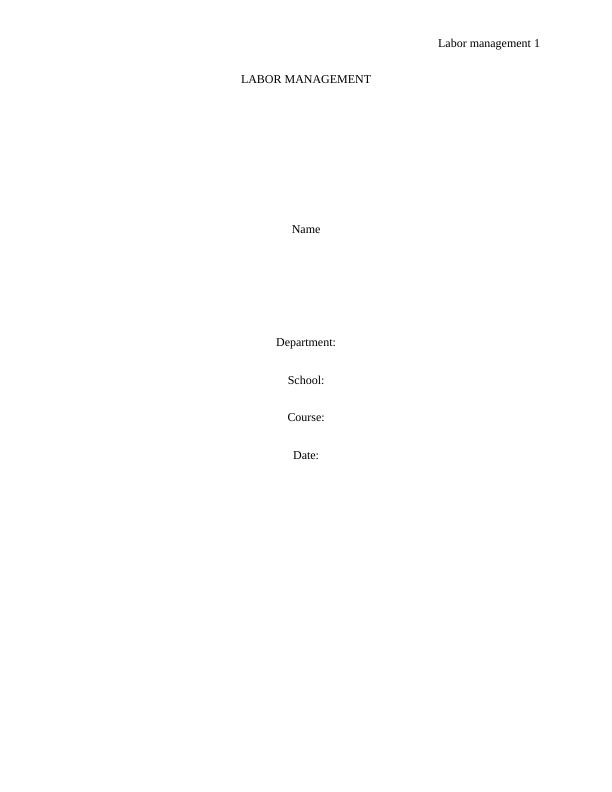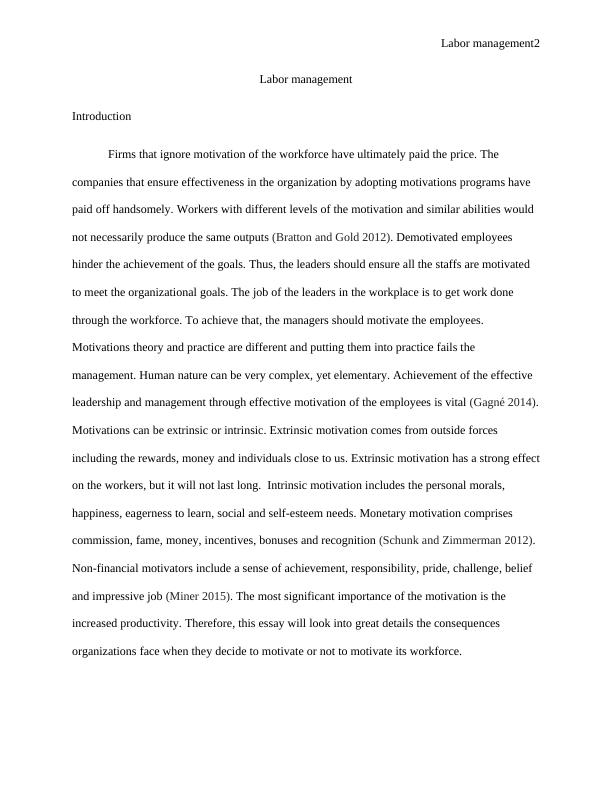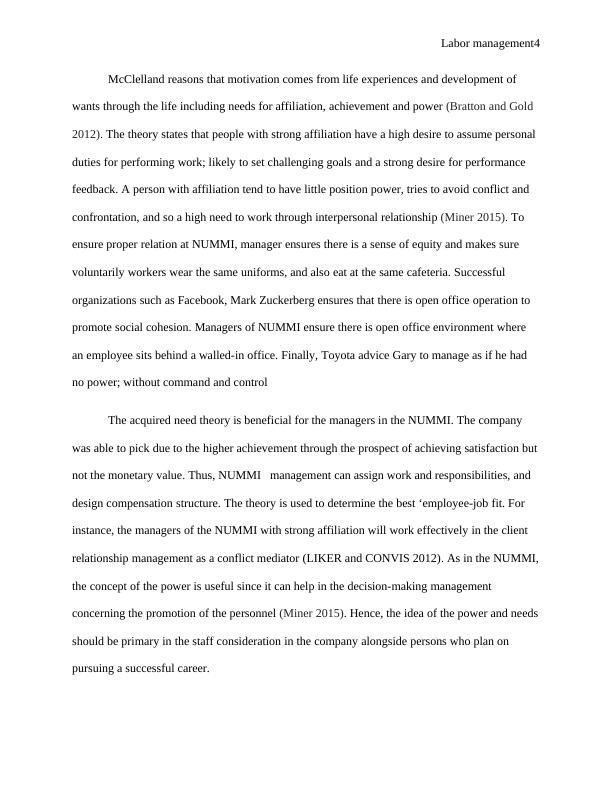Labor Management - MGMT 4626 - Report
Added on 2020-03-07
11 Pages2815 Words64 Views
Labor management 1LABOR MANAGEMENTNameDepartment:School:Course:Date:

Labor management2Labor managementIntroduction Firms that ignore motivation of the workforce have ultimately paid the price. The companies that ensure effectiveness in the organization by adopting motivations programs have paid off handsomely. Workers with different levels of the motivation and similar abilities would not necessarily produce the same outputs (Bratton and Gold 2012). Demotivated employees hinder the achievement of the goals. Thus, the leaders should ensure all the staffs are motivated to meet the organizational goals. The job of the leaders in the workplace is to get work done through the workforce. To achieve that, the managers should motivate the employees. Motivations theory and practice are different and putting them into practice fails the management. Human nature can be very complex, yet elementary. Achievement of the effective leadership and management through effective motivation of the employees is vital (Gagné 2014).Motivations can be extrinsic or intrinsic. Extrinsic motivation comes from outside forces including the rewards, money and individuals close to us. Extrinsic motivation has a strong effecton the workers, but it will not last long. Intrinsic motivation includes the personal morals, happiness, eagerness to learn, social and self-esteem needs. Monetary motivation comprises commission, fame, money, incentives, bonuses and recognition (Schunk and Zimmerman 2012). Non-financial motivators include a sense of achievement, responsibility, pride, challenge, belief and impressive job (Miner 2015). The most significant importance of the motivation is the increased productivity. Therefore, this essay will look into great details the consequences organizations face when they decide to motivate or not to motivate its workforce.

Labor management3Numerous motivation theories have been put forth including Expectancy theory which focuses on which particular behaviors to perform and the effort to apply. For the NUMMI (New United Motor Manufacturing, Inc. (NUMMI – pronounce “new me”), Company to increase P to O expectancies, the employee gets bonuses and reward depending on the safety, quality and production improvement (Adler and Cole 1995). Additionally, the company believes that employee’s performance is directly proportional to the rewards he or she gets. Building on the same point, company encourages the job rotation for the new hires irrespective of the academic or experience from the previous company. Consequently, the company can develop and match the employee's competencies, thereby increasing E to P expectancies. Henceforth, organizations should emphasize on the motivation, but this is not the case. It is because some companies neither have resources nor time to do so or they choose to ignore it deliberately. According to the Maslow’s, employees have to satisfy the needs from the bottoms to the top one. Maslow gave the hierarchy of human needs based on growth and deficiency needs(Bratton and Gold 2012). In the case of the NUMMI, it is the responsibilities of the leaders to understand employee’s requirements in the social and private life but not just their attitude towards work (OHNO 2014). There is no timeframe in the Maslow theory for the satisfaction of the lower and occurrence of higher level needs. There are numerous ways in which employee seeks the comfort, for instance, the esteem needs. It is because people have different motivation factors within the same level of the Maslow hierarchy (Miner 2015). At the NUMMI, there is noexternal documentation such as physician note. Additionally, the system in place does not question the employee absence (Klier and Rubenstein 2010). Most importantly, management makes an effort to help its employees with the personal problems that may cause attendances issues which comprise the basic needs.

Labor management4McClelland reasons that motivation comes from life experiences and development of wants through the life including needs for affiliation, achievement and power (Bratton and Gold 2012). The theory states that people with strong affiliation have a high desire to assume personal duties for performing work; likely to set challenging goals and a strong desire for performance feedback. A person with affiliation tend to have little position power, tries to avoid conflict and confrontation, and so a high need to work through interpersonal relationship (Miner 2015). To ensure proper relation at NUMMI, manager ensures there is a sense of equity and makes sure voluntarily workers wear the same uniforms, and also eat at the same cafeteria. Successful organizations such as Facebook, Mark Zuckerberg ensures that there is open office operation to promote social cohesion. Managers of NUMMI ensure there is open office environment where an employee sits behind a walled-in office. Finally, Toyota advice Gary to manage as if he had no power; without command and control The acquired need theory is beneficial for the managers in the NUMMI. The company was able to pick due to the higher achievement through the prospect of achieving satisfaction butnot the monetary value. Thus, NUMMI management can assign work and responsibilities, and design compensation structure. The theory is used to determine the best ‘employee-job fit. For instance, the managers of the NUMMI with strong affiliation will work effectively in the client relationship management as a conflict mediator (LIKER and CONVIS 2012). As in the NUMMI,the concept of the power is useful since it can help in the decision-making management concerning the promotion of the personnel (Miner 2015). Hence, the idea of the power and needsshould be primary in the staff consideration in the company alongside persons who plan on pursuing a successful career.

End of preview
Want to access all the pages? Upload your documents or become a member.
Related Documents
HRM 898 | Role of Compensationlg...
|7
|1124
|51
Role of Monetary Rewards in Building Relationship with Employees and Motivating Themlg...
|7
|2167
|89
Understanding Why People Worklg...
|8
|2273
|72
Motivational Theories for Managing People and Systems in Modern Workplacelg...
|7
|1826
|334
Motivation in People Managementlg...
|13
|1775
|174
Understanding why people work: Factors that motivate and demotivate employeeslg...
|8
|2063
|499
